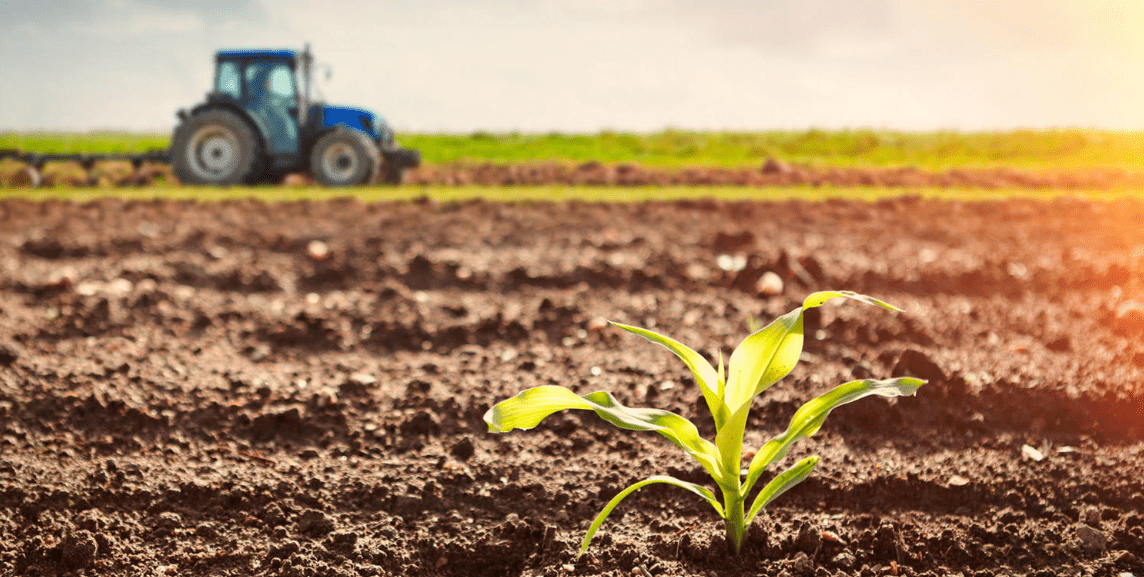
The Australian agriculture sector is crucial to the society and the economy of Australia. It fills millions of Australian bellies with food, offers a variety of job options, and boosts the economy through exports. It is also one of the sectors most vulnerable to climate change, being susceptible to variations in temperature, rainfall, and extreme weather.
” Agriculture is a major cause, life in Australia gets affected by the issue even though it is susceptible to the effects of a changing climate, agriculture must change, then how can we keep feeding the country and having the food options we desire if climate change threatens our current farming practices?”
Before we delve deeper into the current situation, let’s first understand;
Australia’s agriculture-based economy
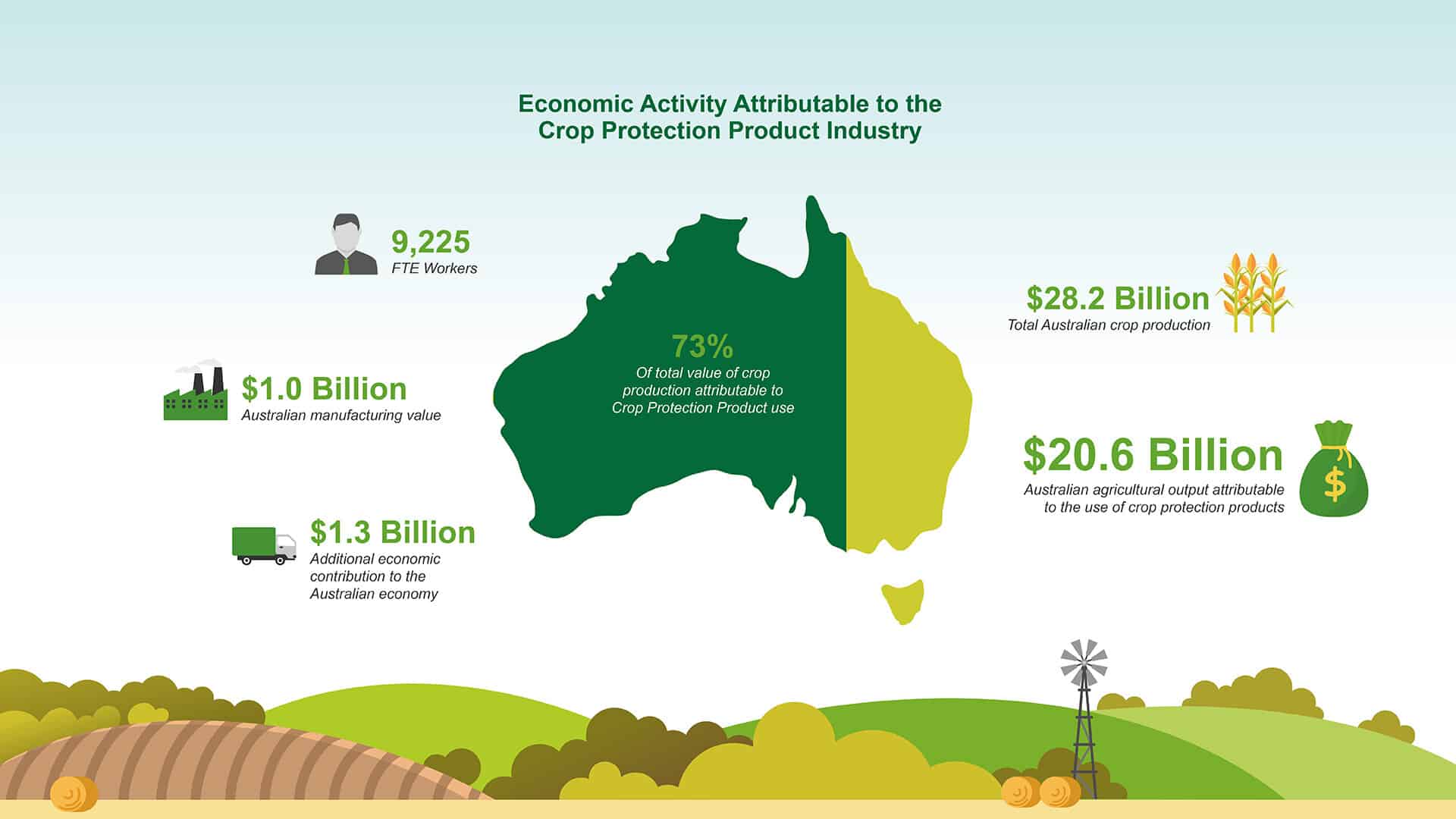
Australia’s agricultural sector is essential to providing for our needs. Australians consume more than 90% of domestically produced food. The success of agriculture not only sustains us but also many Australians and communities in regional towns, with the agriculture, forestry, and fisheries industries employing close to 3% of Australia’s workforce, of which 82% dwell in regional locations. Two-thirds of the food and fibre produced is exported, making up 11% of all products and service exports in 2018–19. Agriculture also generates a considerable amount of export revenue. More than half of Australia’s land is used for agricultural purposes, which is a significant environmental factor.
If we wish to keep growing the quantity and quality of food we need on the limited amount of arable land we have, this land must be managed responsibly.
Australia As a Food Exporting Country
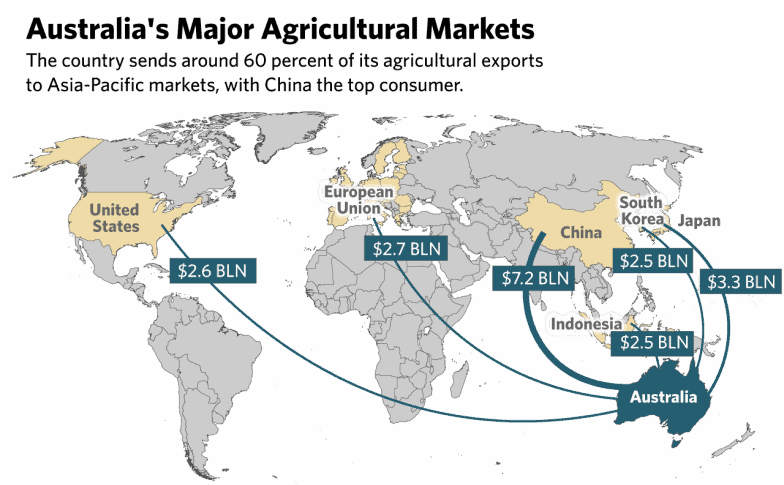
Image source: https://www.stratfor.com/sites/default/files/styles/wv_small/public/australia-ag-influence-map_0.png?itok=ibG2LV1N
Due to the fact that the majority of food produced in Australia is exported, farmers there are subject to the whims of international markets, prices associated with inputs like fertilisers and pesticides, threats to biosecurity, and increasingly severe and frequent unfavourable weather conditions. Compared to farmers in many other nations, Australian farmers only get a little amount of government support. Just over 2% of Australian farmers’ income in 2016–18 came from government assistance. This is much below some of the nations that receive the highest subsidies, such as Norway (61%) Switzerland (55%) and Japan (17%), as well as the average for the Organization for Economic Cooperation and Development (OECD) (46 per cent).
Agriculture includes not only the farm but also the industries that help farmers and the supply chain from the farm to the customer. All participants gain from procedures that increase efficiency throughout the supply chain. Consumers, particularly in Western nations, are increasingly expressing a preference for food that is produced in an environmentally sustainable manner, as well as for food that is wholesome and produced ethically, in addition to flavour, practicality, and cost. Food waste reduction along the entire production chain, including at home, can help to lower demand and boost sustainability.
How Australian agriculture is being impacted by climate change?
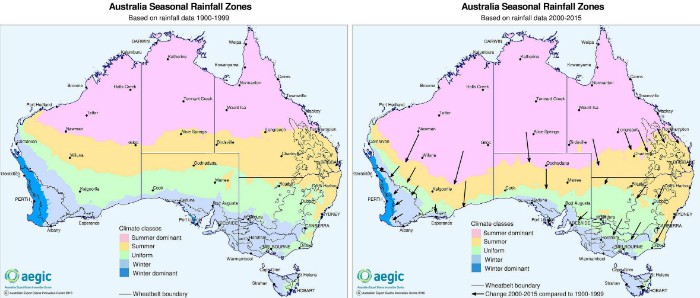
Australian farmers are under additional stress as a result of the recent rise in extreme and intense drought, flooding, and temperature unpredictability linked to climate change in Australia. Farmers now need to adjust their agricultural operations to be productive and economical amid changing climatic circumstances in addition to being vulnerable to market swings.
Although there have been complicated changes in Australia’s climate over the past century, rainfall has generally increased in the north while decreasing in the south. Increases in the frequency of extreme weather events, such as longer droughts and uneven rainfall distribution, go hand in hand with these developments. Australian farmers are being put to the test by climate change, and they will need to keep adapting their methods to keep up productivity in the agricultural sector.
Farmers already employ methods to lessen the impact of Australian climate change. One of these is no-till farming, which prevents soil erosion by not cultivating (ploughing) the field before planting and leaving crop residue on the ground, increasing the amount of carbon that is added to the soil. These methods improve soil structure and fertility, increase water efficiency, lower input costs, and reduce greenhouse gas emissions in addition to absorbing carbon and lowering greenhouse gas emissions.
Australia’s fluctuating precipitation patterns and considerable temperature variations can lead to Following Risks.
Crops Productivity and Quality
Australian wheat yields are stable because of improved crop management techniques. Maintaining crop yields, however, will be very difficult as Australia moves closer to a 2-degree Celcius warming with the corresponding changes in rainfall. Crop nutritional value may change in addition to yield.
Biosecurity
Crops and livestock may suffer as a result of the spread and presence of diseases and pests. Applications of pesticides could not be a good answer, which could result in pest resistance and have a detrimental impact on the environment.
Heat stress in animals
Heat-stressed animals have smaller appetites and are less inclined to reproduce, which results in considerable output losses for the cattle sector. This varies by region; for instance, dairy output has increased in several Southern Australian districts.
Crop and Livestock Distribution
Crops currently grown in certain locations may no longer be sustainable; for instance, wine grape plants may need to be relocated to cooler places to maintain their quality qualities. Forage and pasture output for animals is decreased by less rain and higher temperatures.
In addition to being harmed by climate change, farming itself also contributes to it. Examples of these actions include the clearing of forests to make way for agriculture and the release of greenhouse gases as a result of the intestinal fermentation of ruminant animals. 13% of Australia’s greenhouse gas emissions in 2019 came from agriculture. Methane, a more potent greenhouse gas than carbon dioxide, is produced by cows and other ruminants and accounts for 37% of the emissions associated with human activity.
Australian farmers are aware of these problems; in 2017, they promised to make the red meat industry carbon-neutral by 2030. Additionally, National Farmers Federation members recently supported a historic climate change policy that backs the aspirational goal of net zero carbon emissions for the whole economy by 2050.
How Australia’s agricultural profitability has suffered as a result of climate change
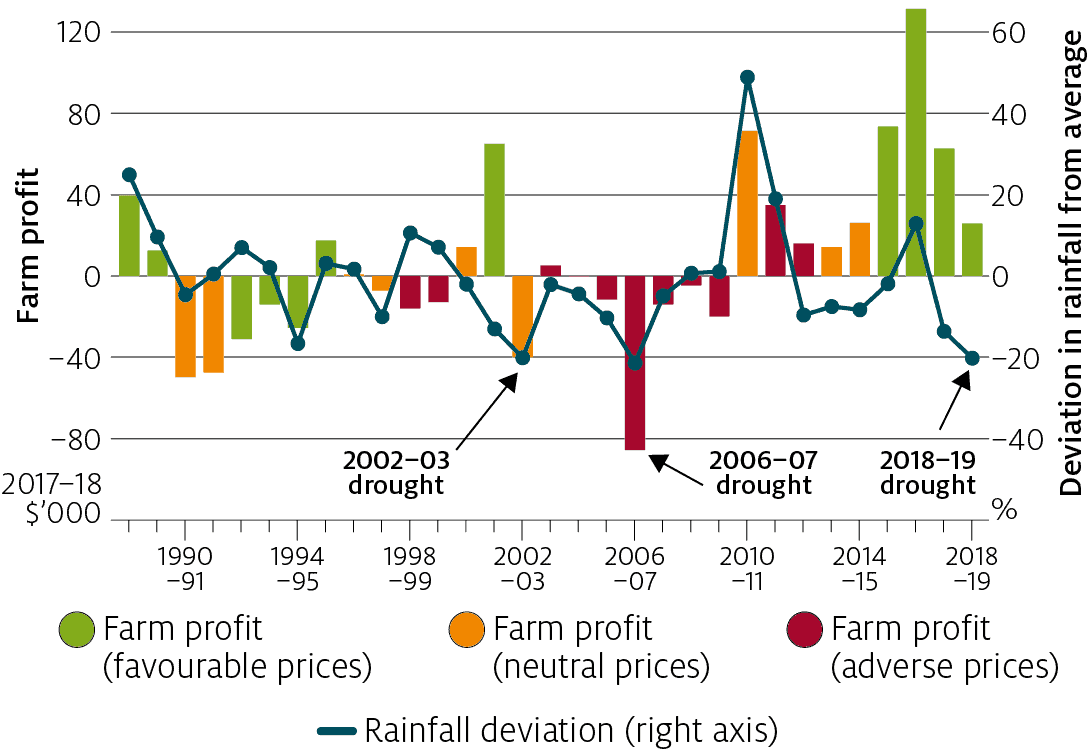
A study compares from 2000 to 2019 with that from 1950 to 1999 while leaving other variables, such as farm output and commodity prices, equal. It observes that average temperatures have risen by around 1C since 1950.
- According to the agricultural department, climate change has decreased Australian farmers’ average annual profitability by 22%, or roughly $18,600 per farm, during the previous 20 years.
- According to a report published by the Australian Bureau of Agricultural and Resource Economics and Sciences, since 2000, climatic changes have caused cropping farms in Australia to lose an average of $1.1 billion in annual revenue.
A statistical model called Farmpredict was created by the Department of Agriculture’s Abares division of science and economics research utilising information from 40,000 farm observations to simulate variations in more than 50 physical and monetary form factors.
Broadacre farms in Australia have been less profitable since 2000 as a result of climate change. Only farms in the Northern Territory saw an increase in profitability, up 8.7%, while climate change was blamed for drastic profit losses in Victoria (-37.1%), Western Australia (-25.8%), and New South Wales (-25.5%).
Cropping farms were the most severely affected, with income falling by 8% or about $82,000 per farm, and profitability falling by 35% or about $70,900 for a typical cropping farm.
The recent drought that has affected a large portion of eastern Australia, according to the Abares research, “has illustrated the significant effects that climate unpredictability may have on agricultural enterprises and households.”
According to the article, Western Australia and other less drought-affected regions, including NSW, had increases in income as a result of high grain and animal commodity prices, whereas drought-affected NSW saw “significant declines in profit in 2018-19.”
Offering assistance to agricultural businesses and individuals during drought conditions runs the risk of preventing industry structural change and innovation, claims Abares. It is very impossible to avoid this problem.
In certain instances, well-intended measures might also penalise farmers who have been better prepared – or fortunate – than farmers who are given aid and relief, weakening management incentives and posing challenging equality challenges.
It suggests that drought policy should “increase resilience and enhanced productivity” in addition to helping to struggle agricultural households.
The Australian Government’s response to the situation

Although prominent government officials, such as the Nationals leader Michael McCormack, frequently emphasise that Australia’s environment has traditionally been characterised by periodic drought and flood, climate change is making the drought in that country worse.
The $5 billion drought future fund, the centrepiece of the Coalition’s drought strategy, will disburse $100 million a year to increase resilience.
The government promised an additional $1.5 billion in November for drought assistance, which would be split into a $1 billion package of low-interest loans for farmers and small companies hit by the drought and a $500 million “direct investment into communities” fund.
A cropping farm’s profit will drop from about $230,000 in a usual year to a loss of $125,000 in a dry year, according to the Abares report’s model of the effects of drought.
In a dry year, an Australian beef farm’s profit drops from $60,000 in a regular year to a loss of $5,000.
What impact do these agricultural developments have on the general public?
Food costs fluctuate according to agricultural profitability and market pricing, which are influenced by climate change and changes in rainfall. For instance, when there is a severe drought and the cost of livestock fodder is high, farmers destock their herds, which raises the price of meat.
Climate change may affect where certain nuts, fruits, and pastures may grow, which may have an influence on cattle and dairy output if more dire predictions come true. Are people willing to renounce the known foods and food quality?
Positively, consumer culinary preferences are changing as a result of how agriculture is affecting climate change. Plant-based proteins are more and more in demand on the market. Australians increasingly have access to plant-based goods that resemble meat and dairy products as farmers adjust to the transition.
When it comes to food provenance, Australian consumers are quite interested in where their food comes from. The ecological effects of production on farms, in later processing, and during transit, for instance, may be of interest to customers who desire to reduce their environmental impact and the corresponding contribution to climate change. To decrease food labelling fraud, dependable certification technology for food products will be needed. It is noteworthy because Australia’s agricultural industry is a world leader in the creation and implementation of these technologies.
Is Australian agriculture headed for a bright future?
The predicted use of cutting-edge agricultural technologies will result in several changes in farm management and allow agricultural production to stabilise or increase without negatively affecting the environment or converting more non-agricultural land. Improved biodiversity conservation should follow if these strategies are successful in reducing the negative effects of climate change.
Consumer awareness of difficulties with agriculture and the food chain has expanded as a result of the COVID-19 epidemic. These include the vital significance of agriculture and the supply of food, as well as the necessity of strong domestic supply chains in many businesses, notably in the case of locally produced foods. The necessity to prevent having many people labour in close proximity has affected processing, particularly of meat, and consumers are aware of the limited availability of migrant workers to harvest crops. The pandemic’s long-term effects could hasten changes in production technology and related consumer preferences.
There is a need for a workforce in rural areas with a variety of skills and training, as opposed to those that are often connected with the industry. For instance, on-farm sensors, robotics, and automation will free up agricultural workers’ time to focus on complicated jobs rather than simple ones that need for little ability.
The production of wholesome, nutritious foods with known provenance from effective, creative, and sustainable farming methods, as well as strong and robust biosecurity measures to manage the dangers of pests and diseases, are essential for our country’s current and future export success.
For all Australians, the viability of our agricultural businesses is essential. In addition to keeping food on our plates, Australian food products command high prices in export markets because they are created to meet the demands of picky and wealthy consumers abroad. In order to lessen the effects of climate change on agriculture and assure environmentally sustainable farming practises into the future, it is essential to invest in fundamental or discovery research as well as innovative technology.
